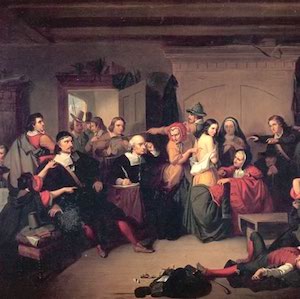Salem Witch Trials Documentary Archive
This archive houses a fantastic collection of source materials pertaining to the 160 women and men accused of witchcraft in the late 17th century in the Massachusetts Bay colony. The extensive material accessible here will be of great use to instructors focusing on such topics as New World transformations of European society, the creation of social deviancy, and the dynamics of race, class, and gender in colonial New England.
The bulk of the documentation available at the site consists of a new transcription of the court trials of accused witches. These transcripts, filling three volumes in 1,000 pages of text, were published in book format in 1977, but this online resource is valuable for several reasons. The texts are immediately accessible; they can be easily searched by keyword; there is a name index; and this new transcription corrects about a dozen significant errors reproduced in previous publications.
Along with the transcripts, several other types of sources are available here. There are links to digital texts from six regional archives. The site contains documents from the Salem Village Church Record Book and scanned copies of six texts treating witchcraft published between the 17th and 19th centuries. In addition, there are seven maps, including one that places the nearly 300 people mentioned in the transcripts in their actual household locations in Salem and the surrounding villages. Finally, there are dozens of images illustrating different eras’ representations of the trials.
The site provides substantial background information to facilitate students’ comprehension of the records. There are close to 50 contextual essays of 1,500 words, written by undergraduate students at the University of Virginia each presenting a biographical overview of many of the subjects—denouncers, prosecutors, and defendants—whose stories are treated here. Over half of these biographies deal with women. The inclusion of broader material on the Massachusetts Bay colony and the general dynamics of the English colonies is beyond the scope of the site, but instructors will find a useful general treatment in Alan Taylor’s American Colonies. For more specific information on women and the witchcraft trials, they might consult Mary Beth Norton’s recent In the Devil’s Snare: The Salem Witchcraft Crisis of 1692.
One of the most widely-known episodes in American history, the Salem witch trials have been subject to differing interpretations across time. Scholars have explained the accusations, variously, as the result of economic tensions, the expression of misogyny, and as the mechanism by which a community can manufacture solidarity through the politics of exclusion. Teachers could encourage students to use the documentary evidence at the site to evaluate such explanations, or to develop new ones. The materials amassed here lend themselves to a close reading of the particular relationships between the historical actors in the community of Salem. Students might perform a name search on one of the characters involved in the trials and then track that individual’s story, plotting out the webs of social connections that existed between prosecutors, accusers, and the accused.
Students could also use this material to examine the transformation of a European category of social deviancy in its New World setting. Instructors could present a brief history of the European witch-hunts and then have students examine interrogations of women and men at this site. Are there elements in the Salem investigations that seem particularly distinctive to the setting of Massachusetts Bay and to the dynamics of colonial life, including in terms of ethnic relations?
Alternatively, teachers might focus on the material presented here concerning Tituba, the most notorious historical character involved in the trials. Popularly depicted for decades as an African slave, more recent writers have uncovered evidence of her South American indigenous ancestry. Students could investigate the construction of Tituba’s racial identity by contrasting evidence about her contained in the transcripts with her presentation in later sources, including in some of the images at the site. When, how, and why was Tituba’s racial identity transformed? Why did Tituba, in particular, become the object of such fascination for later generations of Americans who learned of the trials?
